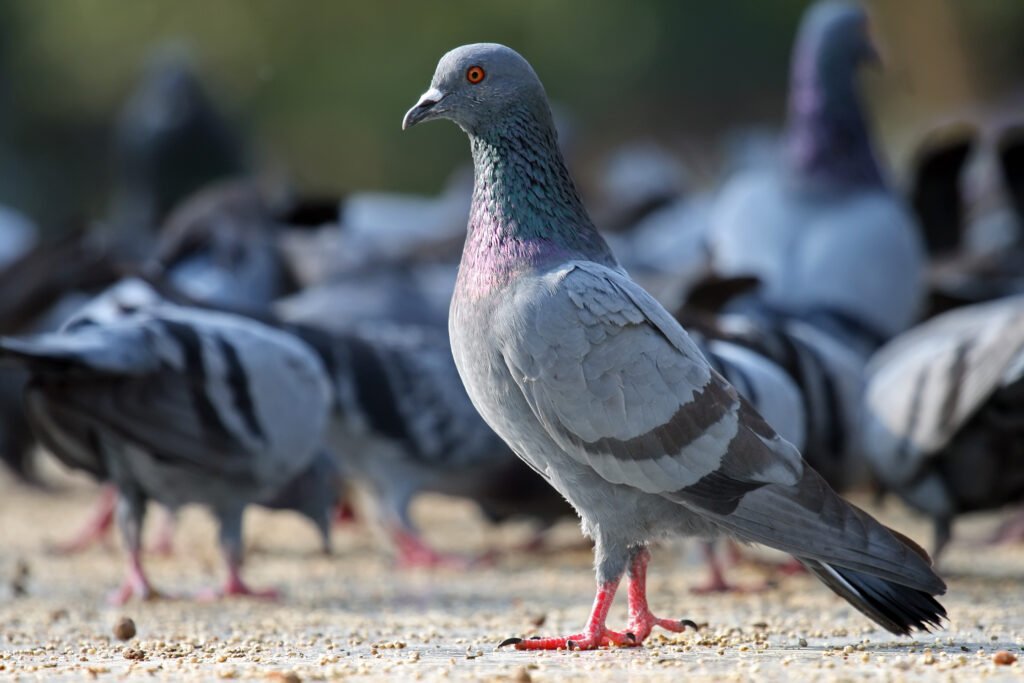The rock dove, also known as the rock pigeon, feral pigeon or common pigeon, been a part of human life for thousands of years. It’s ubiquity across cities, and rural areas in many countries around the world makes the rock pigeon an interesting species to observe and study. In this article, we will look at its physical characteristics, distribution and habitat preferences; explore what it eats; identify potential predators; and consider its relationship with humans throughout history. So whether you’re an amateur bird watcher or just curious about Columba livia – read on.
Overview Of The Rock Dove
The rock dove (scientific name Columba livia), is a species of bird in the family Columbidae. It is distributed across various habitats, ranging from temperate to subtropical regions in Europe, Asia, North Africa and Australia. The rock dove has been tamed for many years and can be seen inhabiting cities worldwide.
Rock pigeons typically form large flocks that feed together on grain crops such as wheat or barley, but they will also eat insects when available. They build nests out of twigs and other materials which are often placed under bridges or ledges of buildings where they can find shelter from predators like hawks or cats.
Rock Dove Physical Characteristics
The rock pigeon has a distinctive grey-blue plumage with two black bars on its wings. Its head is usually white but may also have dark feathers near its eyes or neck. Its bill is yellowish-orange, and has red feet with long claws adapted for perching on rocks or buildings. Males, compared to females, tend to be bigger and possess a more bent bill.
Rock pigeons have short necks thick bodies and small heads. Measuring 28-36 cm (11-14 in.) from bill tip to tail tip, rock doves boast a wingspan of 65 cm (25 in.), rendering them medium-sized birds. Their plumage varies from greyish blue to brownish black, with white patches on their wings and tails. Males tend to have more colourful feathers than females, often having iridescent green or purple neck feathers when seen in sunlight.
Rock doves have a distinctive red patch around their eyes, giving them an alert look, along with yellow feet and bills. The iris colour varies from light brown to orange-red depending on age, gender, seasonality, diet, etc. Adult males tend to have darker feathers than females, while juveniles will usually be lighter in colouration than adults due to moulting patterns.

Distribution & Habitat
Wild rock doves inhabit areas around human settlements such as farms, cities, townships, parks and other open spaces where they find food sources like grains or seeds scattered by people. They are also found near cliffs along coasts or mountains where they build nests in crevices among rocks or ledges; hence one of their common names, “rock pigeon”. Wild rock pigeons can be spotted in many areas, stretching from Alaska to Mexico and Central America in the Americas; Western Europe, including parts of Scandinavia, North Africa and India/China across Asia.
In its native habitat, the rock dove inhabits open woodlands with trees or rocky cliffs near water sources such as rivers or lakes. They will often build their nests on ledges in these areas, which protects them from predators while still allowing them access to nearby food sources.
Columba livia is an adaptable species that can live in a variety of habitats, including urban environments like parks and gardens where they find ample food resources such as discarded breadcrumbs or bird seeds scattered by people feeding wild birds. These pigeons may even nest inside buildings if given access to suitable nesting sites indoors, like attics or rafters under roofs etc.
The Rock Dove’s Diet
The diet of this species consists mainly of grains, seeds, fruits, and vegetables. Rock pigeons are known to consume bugs, like grasshoppers and caterpillars, in addition to their typical diet of grains, fruits, seeds and veggies. In addition to these food sources, they will also scavenge for scraps from human garbage or discarded food items.
Rock pigeons, in their native environment, consume a variety of wild grains such as wheat, barley and oats, along with other vegetation like clover and dandelion leaves. These birds have even been observed eating berries off trees or shrubs when available. Rock pigeons are opportunistic feeders, which means they take advantage of whatever food source is available at the time, whether it’s from nature or humans.
Rock pigeons may supplement their diet with grit which helps them digest their food more efficiently by grinding up plant material in their gizzards before passing it through the digestive system properly. Grit can come from gravel found on sidewalks or roadsides but some people provide specially formulated poultry grit specifically for birds since it contains additional minerals that help keep them healthy such as calcium carbonate, which aids in eggshell formation during breeding season.
Predators Of The Rock Dove
The most common predator is the peregrine falcon. These birds of prey can reach speeds up to 200 mph when diving for their prey and are capable of catching rock pigeons mid-flight. Other birds, such as hawks and owls, also feed on these urban dwellers.
On land, cats pose a threat to young rock pigeons who haven’t yet developed the ability to fly away from danger quickly enough. Rats will also occasionally feast on eggs or chicks if given the opportunity.
Humans also present an ever-present danger to these birds due to illegal hunting activities that take place in some areas around the world where regulations aren’t enforced properly or at all. In addition, humans often set out poison bait which can be fatal for any bird that consumes it accidentally while searching for food nearby.
Rock Dove’s Relationship To Humans
The relationship between humans and rock pigeons, also known as the rock dove or common pigeon, is a long one. Domestication has been recorded since antiquity. Pigeons have been used for communication purposes in war and peacetime alike, with some breeds being specially bred to carry messages over long distances. Many people cherish these birds for their intelligence and attractiveness, making them popular as companion animals.
Domesticated pigeons now inhabit urban environments across the globe, often scavenging for sustenance from discarded restaurant fare and trash receptacles. This close proximity to humans can lead to health risks associated with avian influenza viruses that are naturally carried by wild populations of these birds but may become more easily transmitted when there is contact between wild and domestic flocks. In addition, feral pigeons may transmit diseases such as salmonellosis through contact with their droppings which contain bacteria that can cause illness in humans if ingested or inhaled.
Pigeon racing has become an increasingly popular sport among enthusiasts who train their birds for competition at local clubs or regional events across Europe and North America. This activity requires careful management of both nutrition and exercise regimes for optimal performance during races which can last up to several hours depending on distance covered by each bird’s flight path.

Ash is a contributing author who has been writing about wildlife for as long as he can remember. He has a vast knowledge of many different types of animals, from the tiniest shrews to the great whales that live in the deepest oceans.
